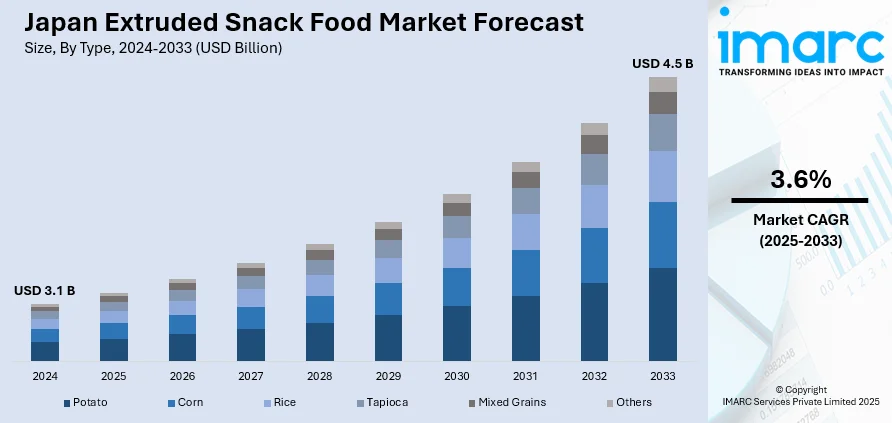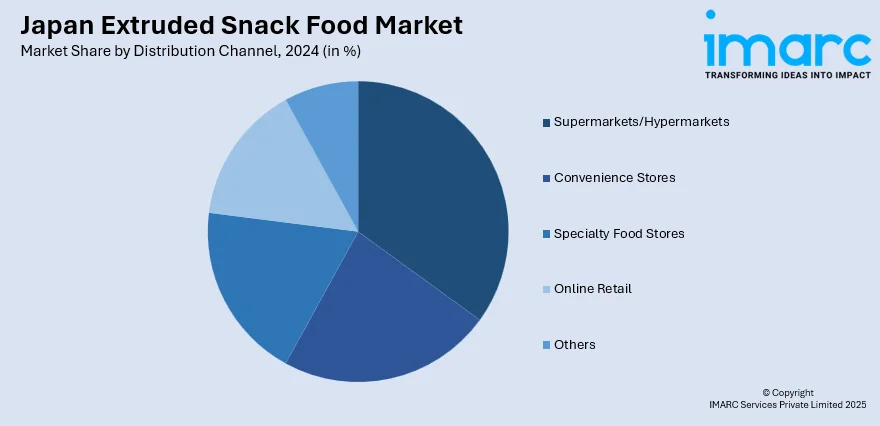
Japan Extruded Snack Food Market Size, Share, Trends and Forecast by Type, Distribution Channel, and Region, 2025-2033
Japan Extruded Snack Food Market Overview:
The Japan extruded snack food market size reached USD 3.1 Billion in 2024. Looking forward, IMARC Group expects the market to reach USD 4.5 Billion by 2033, exhibiting a growth rate (CAGR) of 3.6% during 2025-2033. The market is driven by demand for convenient, on-the-go products, rising interest in unique textures and flavors, increasing influence of health-conscious consumers, and innovations in snack formats. Cultural preferences for portion control and seasonal offerings also contribute to sustained consumer engagement and market expansion.
|
Report Attribute
|
Key Statistics
|
|---|---|
|
Base Year
|
2024
|
|
Forecast Years
|
2025-2033
|
|
Historical Years
|
2019-2024
|
| Market Size in 2024 | USD 3.1 Billion |
| Market Forecast in 2033 | USD 4.5 Billion |
| Market Growth Rate 2025-2033 | 3.6% |
Japan Extruded Snack Food Market Trends:
Growth of Limited-Edition and Seasonal Flavors
Japanese consumers show strong enthusiasm for limited-edition and seasonal snack releases, a trend that significantly shapes product development in the extruded snack segment. Manufacturers frequently introduce snacks tied to local festivals, holidays, or specific seasons—such as cherry blossom-flavored corn puffs in spring or roasted sweet potato variants in autumn. These time-sensitive offerings stimulate frequent purchases, create a sense of novelty, and encourage brand loyalty. Moreover, the scarcity element enhances perceived value, prompting trial by both loyal and new consumers. This marketing approach aligns well with Japan’s culture of seasonal appreciation and fosters deeper brand engagement. As a result, companies increasingly rely on agile production strategies and creative R&D to support the high turnover of seasonal flavor innovations in extruded snack categories. For instance, in September 2023, Nissin Foods introduced Gaming Cup Noodle Energy Garlic & Black Pepper Yakisoba and Gaming Curry Meshi Energy Ginger Keema Curry—two instant meals tailored for gamers in Japan. Designed for convenience and energy, these products contain caffeine, arginine, and niacin to help maintain alertness during extended gaming sessions. Both are sauce-based to minimize mess, making them ideal for consumption between gameplay. With unique packaging and flavors, the meals target the growing overlap between food and gaming culture.

Incorporation of Traditional Japanese Ingredients
There is a noticeable shift toward incorporating traditional Japanese ingredients such as matcha, seaweed, miso, yuzu, and soy-based elements into extruded snacks. This trend caters to a dual demand: maintaining cultural authenticity and providing unique sensory experiences. Brands are blending these heritage flavors with modern snack formats to appeal to both domestic consumers and international buyers seeking Japanese culinary experiences. The integration of traditional components also helps differentiate products in a highly saturated market, reinforcing premium positioning and artisanal value. Additionally, these ingredients often align with perceptions of health and naturalness, appealing to the wellness-focused segment of the consumer base. For instance, a survey conducted in Japan in February 2023 found that the most common perception of traditional Japanese food (washoku) is its healthiness. More than 65% of respondents identified this as a key characteristic. The use of seasonal ingredients also stood out, with many associating washoku with meals centered around white rice accompanied by side dishes such as soup, pickles, and grilled fish prepared with ingredients in season. This fusion of heritage and convenience continues to influence product innovation across leading Japanese snack brands.
Japan Extruded Snack Food Market Segmentation:
IMARC Group provides an analysis of the key trends in each segment of the market, along with forecasts at the country/regional levels for 2025-2033. Our report has categorized the market based on type and distribution channel.
Analysis by Type:
- Potato
- Corn
- Rice
- Tapioca
- Mixed Grains
- Others
The report has provided a detailed breakup and analysis of the market based on the type. This includes potato, corn, rice, tapioca, mixed grains, and others.
Analysis by Distribution Channel:

- Supermarkets/Hypermarkets
- Convenience Stores
- Specialty Food Stores
- Online Retail
- Others
A detailed breakup and analysis of the market based on the distribution channel have also been provided in the report. This includes supermarkets/hypermarkets, convenience stores, specialty food stores, online retail, and others.
Regional Insights:
- Kanto Region
- Kansai/Kinki Region
- Central/ Chubu Region
- Kyushu-Okinawa Region
- Tohoku Region
- Chugoku Region
- Hokkaido Region
- Shikoku Region
The report has also provided a comprehensive analysis of all the major regional markets, which include Kanto, Kansai/Kinki, Central/ Chubu, Kyushu-Okinawa, Tohoku, Chugoku, Hokkaido, and Shikoku Region.
Competitive Landscape:
The market research report has also provided a comprehensive analysis of the competitive landscape. Competitive analysis such as market structure, key player positioning, top winning strategies, competitive dashboard, and company evaluation quadrant has been covered in the report. Also, detailed profiles of all major companies have been provided.
Japan Extruded Snack Food Market News:
- In February 2025, Undercover Snacks launched Undercover Ingredients, a state-of-the-art processing facility at its East Hanover, NJ headquarters, to scale the in-house production of crisped quinoa and other superfood ingredients. Using a proprietary, all-natural method without extrusion, oil, or additives, the facility ensures consistent, high-quality quinoa supply while enabling product innovation across snacks, cereals, nutrition bars, and GLP-1-friendly foods.
- In August 2024, Japanese restaurant operator Fujiya introduced Nikugoe, a new plant-based meat line made from sorghum (takakibi), a nutrient-rich grain known for its robust structural properties. The lineup includes products such as Hamburg Steak, Meat Super Cheese Hamburger, and Meat Super Gyoza, designed to closely replicate the taste and texture of real meat.
Japan Extruded Snack Food Market Report Coverage:
| Report Features | Details |
|---|---|
| Base Year of the Analysis | 2024 |
| Historical Period | 2019-2024 |
| Forecast Period | 2025-2033 |
| Units | Billion USD |
| Scope of the Report |
Exploration of Historical Trends and Market Outlook, Industry Catalysts and Challenges, Segment-Wise Historical and Future Market Assessment:
|
| Types Covered | Potato, Corn, Rice, Tapioca, Mixed Grains, Others |
| Distribution Channels Covered | Supermarkets/Hypermarkets, Convenience Stores, Specialty Food Stores, Online Retail, Others |
| Regions Covered | Kanto Region, Kansai/Kinki Region, Central/Chubu Region, Kyushu-Okinawa Region, Tohoku Region, Chugoku Region, Hokkaido Region, Shikoku Region |
| Customization Scope | 10% Free Customization |
| Post-Sale Analyst Support | 10-12 Weeks |
| Delivery Format | PDF and Excel through Email (We can also provide the editable version of the report in PPT/Word format on special request) |
Key Questions Answered in This Report:
- How has the Japan extruded snack food market performed so far and how will it perform in the coming years?
- What is the breakup of the Japan extruded snack food market on the basis of type?
- What is the breakup of the Japan extruded snack food market on the basis of distribution channel?
- What is the breakup of the Japan extruded snack food market on the basis of region?
- What are the various stages in the value chain of the Japan extruded snack food market?
- What are the key driving factors and challenges in the Japan extruded snack food?
- What is the structure of the Japan extruded snack food market and who are the key players?
- What is the degree of competition in the Japan extruded snack food market?
Key Benefits for Stakeholders:
- IMARC’s industry report offers a comprehensive quantitative analysis of various market segments, historical and current market trends, market forecasts, and dynamics of the Japan extruded snack food market from 2019-2033.
- The research report provides the latest information on the market drivers, challenges, and opportunities in the Japan extruded snack food market.
- Porter's five forces analysis assist stakeholders in assessing the impact of new entrants, competitive rivalry, supplier power, buyer power, and the threat of substitution. It helps stakeholders to analyze the level of competition within the Japan extruded snack food industry and its attractiveness.
- Competitive landscape allows stakeholders to understand their competitive environment and provides an insight into the current positions of key players in the market.
Need more help?
- Speak to our experienced analysts for insights on the current market scenarios.
- Include additional segments and countries to customize the report as per your requirement.
- Gain an unparalleled competitive advantage in your domain by understanding how to utilize the report and positively impacting your operations and revenue.
- For further assistance, please connect with our analysts.
 Request Customization
Request Customization
 Speak to an Analyst
Speak to an Analyst
 Request Brochure
Request Brochure
 Inquire Before Buying
Inquire Before Buying




.webp)




.webp)












